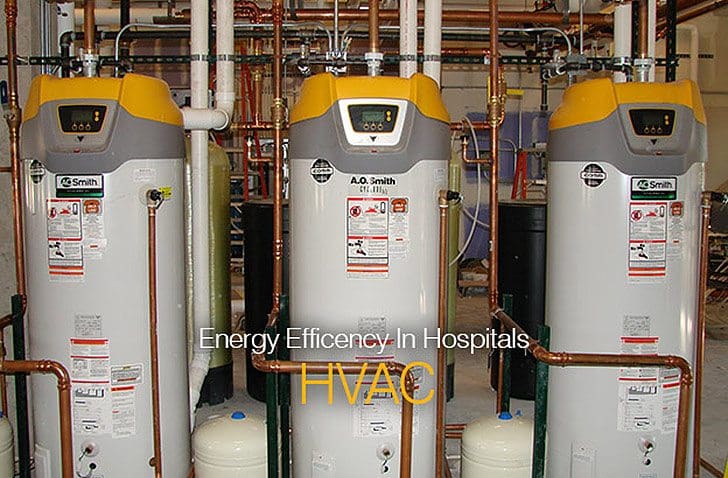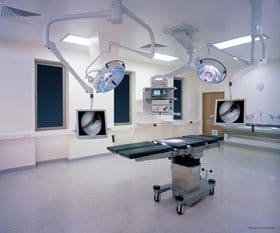
In the following lines we will look at a number of case studies for energy saving options. These are subdivided into the following areas:
– HVAC
– Compressed air
– Steam
– Lighting
– Cogeneration
For each of these areas we first give a general explanation, followed by some practical examples taken from various studies carried out in the Netherlands, Belgium and Germany. In the calculations the following rates are used for gas and electricity:
- Gas price: 30 €/MWh
- Electricity price: 80 €/MWh
The profitability calculations are done on the basis of the energy savings achieved, without taking into account any government subsidies or maintenance savings that could further reduce the payback period, since government subsidies vary greatly from one country to the other.
The underlying formulas and calculations are not presented in this guide; only the results are given.
HVAC
For climate control of the various buildings and applications in a hospital there are usually various air conditioning units available, spread over the different parts of the building. Depending on the application the air may be heated, cooled, humidified and/or filtered.
Cooling, heating and humidification are generally done by a central generating station of heat and cold.
- Polyclinic and consultancy: used only during “office hours,” with HVAC to suit the comfort of people in these areas.
- Nursing wards: continuously occupied, with HVAC to suit the comfort of the people there.
- Laboratories, dialysis departments etc.: HVAC to control the conditions for the medicines and the tests carried out there.
- Operating theatres and emergency ward: continuously occupied, with HVAC to control the conditions within narrow limits of temperature and humidity. Ventilation and filtering systems are also used to prevent contamination.
- Administrative departments: used only during “office hours,” with HVAC to suit the comfort of people in these areas.
The most important areas that need to be conditioned in a hospital are of course the operating theatres. Separate HVAC units are used in this case, which moreover have to meet the particular regulations that apply (as regards smoothness of inside walls, ease of complete cleaning, etc.).
Such an HVAC unit consists essentially of the following components:
- Fresh air intake section
- Coarse filtration
- Heat recovery unit
- Preheating unit
- Cooling unit
- After-heating unit
- Fan
- Moisturising
- Fine filtration
- Extraction section

The operating theatres themselves are generally fitted with a filter ceiling, i.e. the ceiling consists of a grid fitted with a high efficiency particulate air filter (HEPA) that ensures that no harmful particles are blown into the theatre.
The ventilation works on the downflow principle, with air being blown in from the ceiling at a specified speed directly above the operating table, where there is the most chance of contamination, so as to protect open wounds, surgical instruments etc. Operating theatres are kept at overpressure with respect to neighbouring areas, so as to keep out dirt and contamination.
Most hospitals have several operating theatres, in which case there is usually one central air group that creates the overpressure, supplies fresh air and carries out basic air conditioning for all of them. In addition there is a separate HVAC unit for each operating theatre (or one for every two) that provides the specific conditioning for the required conditions.
The air extraction group is fitted with:
- Coarse filter
- Heat recovery unit
- Fan
- Extraction section
The energy consumption within an HVAC unit is accounted for by the following main applications:
- Heat, for heating the air
- Cold, for cooling and drying the air
- Electricity, to drive the fans
- Steam, to moisturise the air
The commonest energy saving measures for HVAC systems in hospitals are as follows (excluding building design considerations):
- Fitting frequency controllers on the fans
- Recovering heat from the extraction air
- Optimising the running hours
- Optimising the temperature and humidity
Case 1: Reducing the ventilation flow rate in a polyclinic during the night
Introduction
The hospital in this case is a medium-sized institution. There are various HVAC systems within the hospital, with several sub systems for each section of the building. The various HVAC systems are controlled by a building management system, with the HVAC parameters set according to the requirements of the different departments.
Present situation
The polyclinic has its own HVAC installation which operates 24 hours per day, 7 days per week. However, the polyclinic is not open 24/7, which means the HVAC system runs unnecessarily for some of the time.
Proposal
When the polyclinic is not in use, the air flow rate of the HVAC can be reduced to 50%. In theory the system could be switched off altogether, but for the purpose of this calculation a rate of 50% is assumed. It is further assumed that the HVAC system can operate at 50% for 9 hours per day, during which time the humidification can also be switched off.
Estimated savings & investment
The savings achieved are lower electricity consumption of the ventilation fans and lower gas consumption, since less air has to be warmed up and less steam is needed for humidification.
The HVAC settings are currently as follows:
| Ventilation air supply rate : | 3 800 m3/h |
| Temperature : | 17 ºC |
| Relative humidity : | 70 % |
| Ventilation operating hours : | 24 h/day |
On the basis of the above parameters, the saving can be calculated as follows:
| Period of reduced setting : | 9 h/day |
| Electricity consumption saving (ventilator fans) : | 10 MWhe |
| Degree-hours on basis of 17°C (+1°C with respect to ventilator) : | 21 577 hK/a |
| Gas consumption saving (heating) : | 7.6 MWhth |
| Number of humidification gram-hours : | 1 437 h/a*g/kg |
| Assumed efficiently of steam generation + transport : | 90 % |
| Gas consumption saving (steam) : | 5.1 MWhth/year |
| Water savings (for information, not included in the calculation) |
The annual energy savings amount to 10 MWhe/year and 13 MWhth/year, or a financial saving of €1190 per year. The required investment is nil.
Case 2: Heat recovery in an HVAC group
Introduction
The hospital in this case is a medium-sized institution. In the hospital there are various HVAC systems; most of them have heat recovery but some do not.
Present situation
At present there is no heat recovery from the extraction air in the office HVAC systems, which means that energy is lost unnecessarily. In the air ducts leading to and from the HVAC unit there is sufficient space to install heat recovery.
Proposal
A Twin-Coil heat recovery system could recover around 50% of the heat from the extraction air. The Twin-Coil system was chosen because of the practical feasibility of installing it in the existing air ducts.
Estimated savings & investment
The savings are achieved in terms of gas consumption, because less air needs to be heated due to the fact that some of the pulsed air is heated using heat from the extraction air. On the other hand the amount of electrical power consumed is higher, since fitting a Twin-Coil creates additional resistance in the air duct which has to be overcome by the fans.
The HVAC settings are currently as follows:
| Ventilation air supply rate : | 10 500 m3/hour |
| Temperature : | 18 ºC |
| Relative humidity : | 55 % |
| Ventilation operating hours : | 18 h/day |
On the basis of the above parameters, the saving can be calculated as follows:
| Present gas consumption (heating) : | 170 MWhth |
| Degree-hours on basis of 18°C (+1°C with respect to : | 42 950 hK/year |
| Efficiency of Twin-Coil heat exchanger : | 50 % |
| Gas consumption saving (heating) : | 85 MWhth |
| Additional electricity consumption (fans) : | 4 MWhe |
The annual energy savings amount to -4 MWhe/year and 85 MWhth/year, or a financial saving of €2230 per year. The investments comprise installation of a Twin-Coil heat recovery unit in the air ducts leading to and from the HVAC unit.
The estimated amount of the investment is € 15 000, resulting in a payback time of 6.7 years.











Hi
Fresh air bring in lot of load especially in tropical climatic conditions. Arka Two Stage Air conditioning solutions save substantial energy as compared to conventional technologies. Low energy sensible cooling is key differentiation of this unique configuration. Happy to assist those who interested to save energy.
Also what could help with certain Hospitals is implementing Power Quality solutions in locations where quality maybe a factor. We have done several evaluations at hospitals with high electrical demand and have concluded that there were many surprising results spread throughout the Hospital location. Having low or poor Power Quality can be fatal to other components tied in to the same systems.
When you said ‘many surprising results spread throughout the Hospital location’, did you mean positive or negative results?
It’s very difficult and expensive to implement modern and energy efficent solutions in existing buildings/hospitals. It is possible, but it requires huge investment. As you said, low or poor power quality something that affects everything in whole system in positive or negative way.